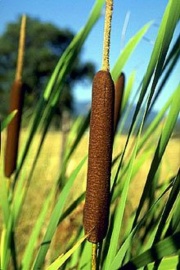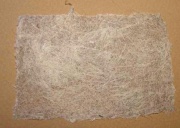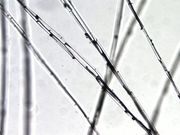Difference between revisions of "Cattail fiber"
| (One intermediate revision by the same user not shown) | |||
| Line 1: | Line 1: | ||
| − | [[File:cattailpd1.jpg|thumb|Broadleaf cattail | + | [[File:cattailpd1.jpg|thumb|Broadleaf cattail ''Typha latifolia'']] |
| − | |||
| − | ''Typha latifolia'']] | ||
== Description == | == Description == | ||
| Line 8: | Line 6: | ||
== Synonyms and Related Terms == | == Synonyms and Related Terms == | ||
| − | + | [[File:image7_cattailfiber.jpg|thumb|Cattail fiber paper]] | |
typha; typhus; bulrush (Br.); bullrush (Br.); reedmace (old Br.); ''Typha latifolia'' (broadleaf cattail, common bulrush); ''Typha augustifolia'' (Narrowleaf cattail, lesser bulrush); ''Typha minima'' (Dwarf bulrush); vezel van de kattenstaart of lisdodde (''Typha latifolia'') of paardenstaart (genus ''Equisetum'') of doddegras (genus ''Phleum'') of wilgenkatje (Ned); | typha; typhus; bulrush (Br.); bullrush (Br.); reedmace (old Br.); ''Typha latifolia'' (broadleaf cattail, common bulrush); ''Typha augustifolia'' (Narrowleaf cattail, lesser bulrush); ''Typha minima'' (Dwarf bulrush); vezel van de kattenstaart of lisdodde (''Typha latifolia'') of paardenstaart (genus ''Equisetum'') of doddegras (genus ''Phleum'') of wilgenkatje (Ned); | ||
| − | + | ==Physical and Chemical Properties== | |
| − | == | ||
Fiber length = 25 mm (1 inch). Cross section = round. | Fiber length = 25 mm (1 inch). Cross section = round. | ||
| + | [[File:43 cattail 200X.jpg|thumb|Cattail fibers at 200x]] | ||
| + | [[File:43 cattail 200X pol.jpg|thumb|Cattail fibers at 200x polarized light]] | ||
| + | == Resources and Citations == | ||
| − | + | * G.Cook, ''Handbook of Textile Fibres:I. Natural Fibres'', 5th edition, Merrow Publishing Co., Durham, England, 1984. | |
| − | |||
| − | G.Cook, ''Handbook of Textile Fibres:I. Natural Fibres'', 5th edition, Merrow Publishing Co., Durham, England, 1984. | ||
| − | |||
| − | |||
| − | |||
| − | |||
| − | |||
| − | |||
| − | |||
| − | |||
* G.S.Brady, ''Materials Handbook'', McGraw-Hill Book Co., New York, 1971 Comment: p. 430 | * G.S.Brady, ''Materials Handbook'', McGraw-Hill Book Co., New York, 1971 Comment: p. 430 | ||
Latest revision as of 07:48, 24 May 2022
Description
Short, fluffy fibers obtained from the cylindrical flowers of cattail plants, Typha latifolia and Typha augustifolia. Cattails are found in wetlands and swampy areas throughout North America. The cattail fibers are used for filling pillows, upholstery, and life jackets. They provide sound and heat insulation as well as buoyancy. Cattail leaves were also used to make seats for rush-bottomed chairs.
- For cattail fiber identification, see http://cameo.mfa.org/wiki/Category:FRIL:_Narrow-Leaved_Cattail
Synonyms and Related Terms
typha; typhus; bulrush (Br.); bullrush (Br.); reedmace (old Br.); Typha latifolia (broadleaf cattail, common bulrush); Typha augustifolia (Narrowleaf cattail, lesser bulrush); Typha minima (Dwarf bulrush); vezel van de kattenstaart of lisdodde (Typha latifolia) of paardenstaart (genus Equisetum) of doddegras (genus Phleum) of wilgenkatje (Ned);
Physical and Chemical Properties
Fiber length = 25 mm (1 inch). Cross section = round.
Resources and Citations
- G.Cook, Handbook of Textile Fibres:I. Natural Fibres, 5th edition, Merrow Publishing Co., Durham, England, 1984.
- G.S.Brady, Materials Handbook, McGraw-Hill Book Co., New York, 1971 Comment: p. 430
- Van Nostrand's Scientific Encyclopedia, Douglas M. Considine (ed.), Van Nostrand Reinhold, New York, 1976
- Random House, Webster's Encyclopedic Unabridged Dictionary of the English Language, Grammercy Book, New York, 1997
- The American Heritage Dictionary or Encarta, via Microsoft Bookshelf 98, Microsoft Corp., 1998
- Wikipedia: Typha. Accessed Oct. 30, 2004



